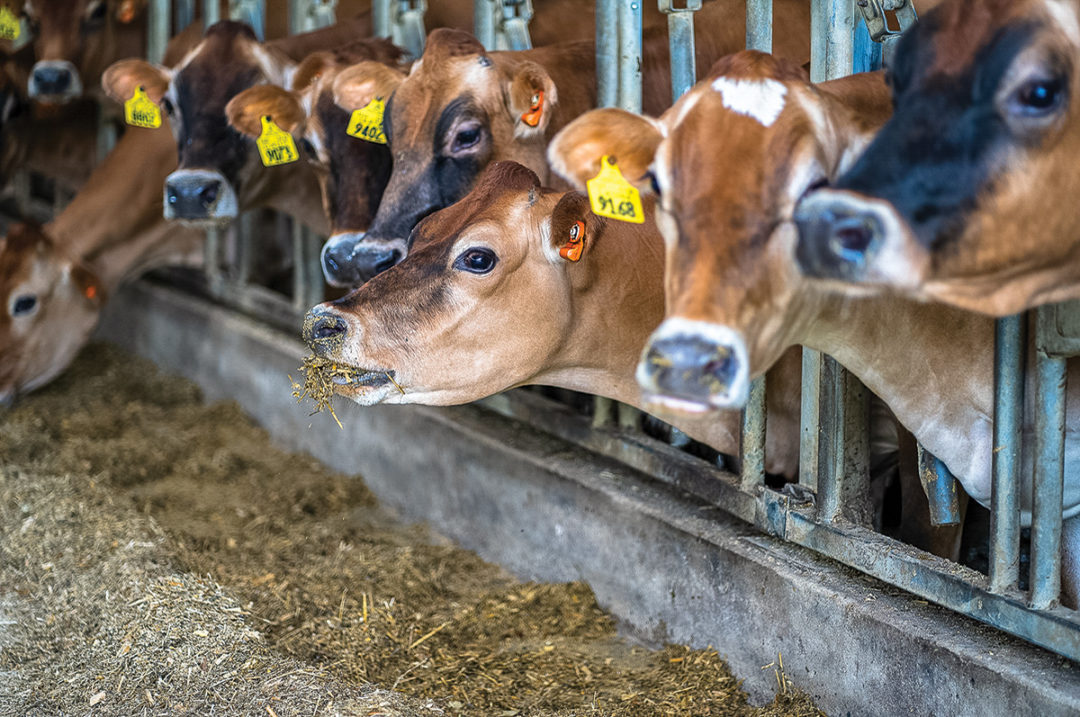Cows on harvested feeds perform better when allowed at least a couple of hours of grazing green, lush pasture. Early feeding observations have suggested hydroponic forages behave similarly, enhancing intake, rumination and nutrient digestibility. Both early vegetative pasture and hydroponic forages are fermentation enhancers, exerting a positive effect on the rumen environment. The secret relies on rapidly digestible protein sources accompanied by rapidly digestible carbohydrates in this type of fresh feed, which increase rumen microbial yield, fiber degradability, microbial protein synthesis, energy absorption and rumen pH. There is, however, an ideal non-structural carbohydrate (NSC) to rumen-degradable crude protein (CP) ratio. The goal of the nutritionist should be to optimize rumen function and thus digestibility of the ingesta by obtaining an NSC-to-degradable-CP ratio that maximizes microbial yield.
Hydroponics experiment
During 2021, our team conducted an experiment to evaluate the productive response of Jersey cows fed hydroponic forage obtained from a new fully automated hydroponic system available on the market. Hydroponically sprouted grains have the advantage of offering highly degradable protein and carbohydrates, particularly an unusually high concentration of sugars. The rapid fermentation of these nutrients optimizes microbial yield in the rumen, which in turn unlocks the nutrients from the other feedstuffs in the diet.
In 2020, the collaborating farm was ranked first in milkfat, third in milk protein and fourth in milk production by the American Jersey Cattle Association. The experimental design was a randomized block with cows blocked by age, production and components. Variables measured were feeding behavior, milk yield, feed efficiency, nutrient digestibility and methane emissions. The comparison period ran from Oct. 14 to Dec. 14, 2021, with a carryover period from Dec. 15, 2021 to Jan. 1, 2022.
The basal diet included the following feeds: alfalfa hay and silage, corn silage, corn grain, corn gluten feed, wheat straw, a protein-molasses supplement, a vegetable bypass protein product, soybean meal, a concentrated source of NSC, bypass fat, minerals and vitamins, and added water. The treatment diet included 7.6 pounds (dry matter basis) of hydroponic forage replacing other feeds for an isonitrogenous and isoenergetic diet. The chemical composition of the diets is in Table 1; as expected, the treatment diet contained significantly higher (p < 0.05) concentrations of sugars because hydroponic forage can contain up to 34% sugars.

Feeding behavior and digestibility
Cows fed the diet that contained hydroponic forage had digestive as well as behavioral changes. The inclusion of hydroponic forage modified eating and rumination patterns. Cows on this treatment spent more time chewing feed. Increased chewing time is usually associated with more total fiber or undigestible fiber in the diet; this was not the case since both diets had the same concentration of neutral detergent fiber (NDF) and acid detergent fiber (ADF) (Table 1). What was different, however, was the NDF digestibility, which was higher (p < 0.05) in the diet with hydroponic forage (Table 2).
 This difference in digestibility though was not enough to exert any changes in intake (Table 3). Interesting to note also is that activity was lower (p < 0.05) in cows on the treatment diet. Despite increased eating and rumination treatment, cows were less active, seemingly being more “contented” with the TMR that contained hydroponic forage. Since increased chewing was not associated with higher intake, it must be associated with greater rumination. The increased rumination activity confirmed that, with cows fed hydroponic forage spending more time ruminating even when there were no differences in the fiber content between both diets.
This difference in digestibility though was not enough to exert any changes in intake (Table 3). Interesting to note also is that activity was lower (p < 0.05) in cows on the treatment diet. Despite increased eating and rumination treatment, cows were less active, seemingly being more “contented” with the TMR that contained hydroponic forage. Since increased chewing was not associated with higher intake, it must be associated with greater rumination. The increased rumination activity confirmed that, with cows fed hydroponic forage spending more time ruminating even when there were no differences in the fiber content between both diets.

Rumen microbial yield
Fiber degradability, microbial protein synthesis, energy absorption and rumen pH can all increase with the inclusion of sugars in a diet adequately balanced for starch. The highest microbial protein yield occurs when a rapidly digestible protein source accompanies a rapidly digestible carbohydrate source. As the NSC-to-rumen-degradable-CP ratio widened from 1.9 to 8.9, microbial yield decreased curvilinearly from 34.2 to 10.3 grams of bacterial nitrogen per kilogram of dry matter (DM) digested.
From Nutritional Dynamic Systems (NDS) output, the treatment diet had a metabolizable protein derived from bacteria of 44.4%, with a metabolizable protein derived from rumen-undegradable protein (RUP) of 55.6%; the control diet had 41.7% and 58.3%, respectively. There was clearly more bacterial protein predicted for the diet with hydroponic forage, and cows in this group relied more on bacterial yield to cover their metabolizable protein needs. We also predicted the efficiency of microbial synthesis from the NSC/degradable protein using the model by Stokes et al.
Cows fed the control diet had 26.3% starch and 7.9% sugars in the TMR, with 53.7 pounds of DM intake. From the composition in Table 1, this represented 6,400 grams of starch and 1,900 grams of sugars for a total of 8,300 grams of NSC. Similarly, cows fed the treatment diet had 25.6% starch and 9.0% sugars in their TMR. Since their intake was 53.1 pounds of DM, this represented 6,240 grams of starch and 2,194 grams of sugars for a total of 8,434 grams of NSC.
Rumen-degradable protein was 568 grams and 535 grams per kilogram for the treatment and control, respectively (NDS). Calculating the degradable protein intake from the measured total feed intake (in kilograms) we have 2,396 grams and 2,272 grams for the treatment and control diets, respectively. Using the NSC values for both diets, we estimated the NSC-to-degradable-protein ratio such that:
Treatment diet: 8300/2,396 = 3.46
Control diet: 8434/2,272 = 3.71
The ratios confirm the microbial trends predicted by the NDS software. The inclusion of hydroponic forage improved the NSC-to-degradable-protein ratio, which increased the efficiency of microbial protein synthesis.
Milk yield and methane production
Cows fed hydroponic forage produced more milk compared to the controls (Table 3 and Figure 1). They also had very high feed efficiency, higher (p < 0.05) than cows in the control diet. Cows produce methane from feed fermentation in the rumen.

The more feed DM they consume, the more methane is produced, part of which is absorbed by the animal and part is lost to the environment. In this instance, however, cows fed hydroponic or control had identical intakes. Total fiber intake can also affect methane production with cows eating more fiber, producing more methane. Both diets, however, had similar fiber contents. There were differences though in methane production, with cows eating hydroponic forage producing 27% less methane than the controls (Table 3). This is explained by the difference in microbial output and feed efficiency observed in the cows fed hydroponic forage compared to the control. A greater feed efficiency allows bacteria to function as a hydrogen sink, leaving less hydrogen in the rumen for the synthesis of methane. Once the hydroponic forage was removed from the diet, both groups had similar intakes, milk yield and methane emission.
 Hydroponically sprouted grains have the advantage of offering highly
Hydroponically sprouted grains have the advantage of offering highlydegradable protein and carbohydrates. Photo provided by Alvaro Garcia.
Results of this experiment validate previous modeling and actual findings that cows eating hydroponic forage had higher feed efficiency resulting from improved rumen function, increased production and reduced methane losses. Because of its demonstrated effects on modulating microbial growth and in turn fiber digestion, hydroponic forages have the effect of a rumination enhancement additive or a functional feed, with effects in the rumen that go beyond its actual chemical composition.












